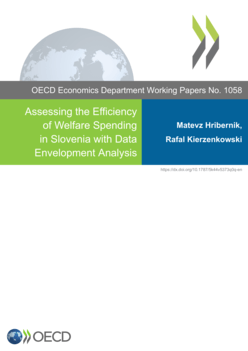Hello! You're looking at a policy document report on Overton
We track government policy, guidelines, think tank research, working papers and more to help our customers see the impact and influence of their work. Are you interested in seeing what information we have to offer? Request a free trial to our platform.
If you fund, produce or manage research or work to influence policy, we'd love to talk. Learn more on our homepage.

Identifiers
Assessing the Efficiency of Welfare Spending in Slovenia with Data Envelopment Analysis
Rafal Kierzenkowski and Matevz Hribernik
This paper derives estimates of the efficiency of welfare spending in Slovenia and the other OECD countries from data envelopment analysis based on model specifications used in earlier OECD studies. Results suggest that Slovenia ranks about 25th among OECD countries for output efficiency: for a given level of spending outcomes fall short by around 3.5% in health care, by 10% in secondary education and by around one third in public administration. Results also suggests that Slovenia ranks 18th to 27th in the OECD for input efficiency as the same outcomes could be reached by scaling back costs by around half. Alternatively, spending increases could be contained and outcomes improved by increased cost efficiency. Statistical uncertainty surrounding input efficiency estimates is high for countries with the smallest scope for potential savings. Confidence intervals around output efficiency scores are also wide for some emerging market economies.
Topics in this document
Data envelopment analysis
OECD
Programme for International Student Assessment
Purchasing power parity
Economy
Economics
Health care
Gross domestic product
Outlier
World Economic Forum
Economic growth
Education
Health
Efficiency
Economic inequality
Related SDGs
SDG 1: No Poverty ...
SDG 1: No Poverty
Target 1.3
Implement nationally appropriate social protection systems and measures for all, including floors, and achieve substantial coverage of the poor and the vulnerable
Citations
Cited by 17
other policy documents
(2 of them are from other policy sources)
